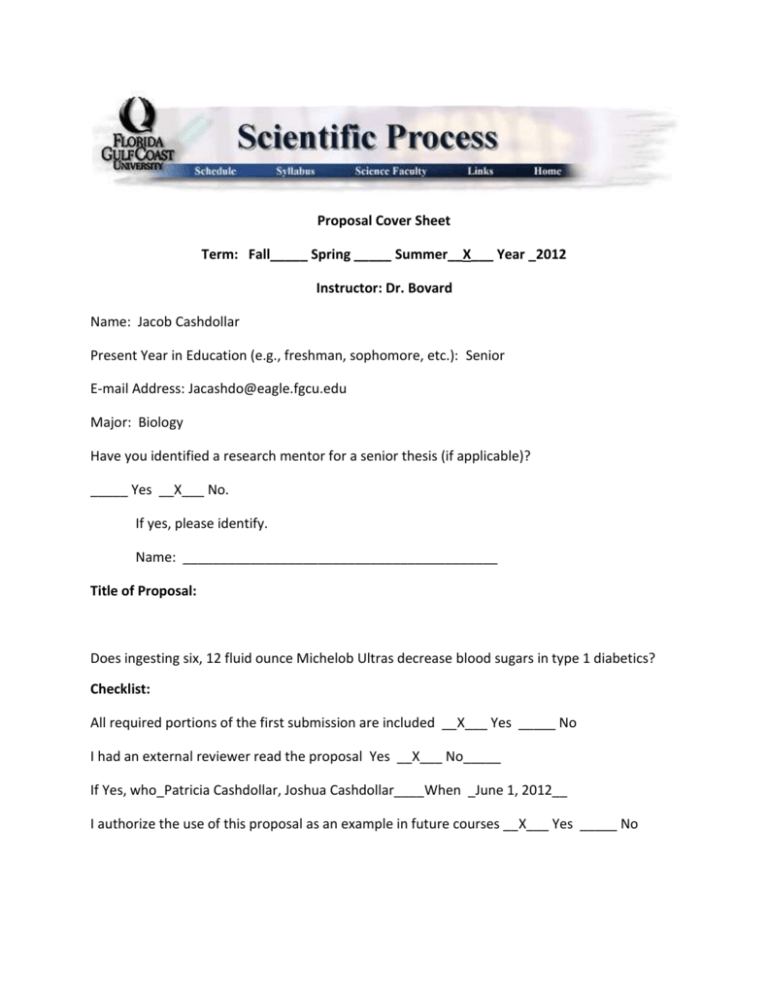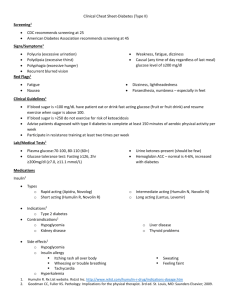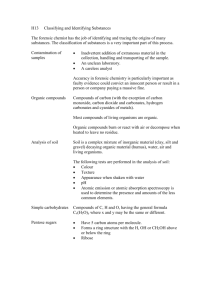Michelob Ultra diabetes Cashdollar 2012
advertisement

Proposal Cover Sheet Term: Fall_____ Spring _____ Summer__X___ Year _2012 Instructor: Dr. Bovard Name: Jacob Cashdollar Present Year in Education (e.g., freshman, sophomore, etc.): Senior E-mail Address: Jacashdo@eagle.fgcu.edu Major: Biology Have you identified a research mentor for a senior thesis (if applicable)? _____ Yes __X___ No. If yes, please identify. Name: __________________________________________ Title of Proposal: Does ingesting six, 12 fluid ounce Michelob Ultras decrease blood sugars in type 1 diabetics? Checklist: All required portions of the first submission are included __X___ Yes _____ No I had an external reviewer read the proposal Yes __X___ No_____ If Yes, who_Patricia Cashdollar, Joshua Cashdollar____When _June 1, 2012__ I authorize the use of this proposal as an example in future courses __X___ Yes _____ No Abstract: Millions of type 1 diabetics suffer from hypoglycemia and low blood sugar. Many might not know that consuming alcohol increases the likelihood of these problems. By becoming aware of this knowledge, future diabetics can be prone to less damage on their bodies and save some from death. By ingesting six beers over a two hour period, and monitoring the individual’s blood sugars over a period of 12 hours, a blood glucose reading being taken every five minutes, we wish to obtain important information about consumption of alcohol and its effects on type 1 diabetics. Keywords: Hypoglycemia, blood glucose, alcohol consumption Table of contents: Page Problem Statement……………………………………………………………………………………………………………….4-5 Research Objective…………………………………………………………………………………………………………………6 Methods……………………………………………………………………………………………………………………………….7-8 Timetable and Project Management………………………………………………………………………………………9 Significance of Expected Results……………………………………………………………………………………………..10 Equipment……………………………………………………………………………………………………………………………….10 Reference Cited………………………………………………………………………………………………………………………..11-12 Biographical Sketch………………………………………………………………………………………………………………….13 Problem Statement: The consumption of alcohol has been correlated with decreased blood sugars and hypoglycemia in type 1 diabetics (1). Alcohol intake has been associated with disabling of the liver (2). When the liver is functioning properly, it releases small amounts of glucose when blood sugars fall too low. Under the influence of alcohol, the liver would be disabled and would not secrete small amounts of glucose. Alcohol consumption and decreasing blood sugars have not only been found when drinking beer, but with many types of alcohol. This includes wine and liquor. A glass of red wine has traditionally been said to lower the risk of heart disease. (3) Diabetics however, are at the risk of low blood sugars and hypoglycemia when consuming alcoholic beverages. Type 1 diabetics are insulin-dependent compared to individuals with type 2 diabetes who are not. An individual being diagnosed with diabetes goes through a process. The patient has to ingest 75 grams of glucose plasma and if after two hours their blood sugars are above 200mg/dL, then the diagnosis is diabetes. (8) Hyperglycemia (high blood sugars) is a key indication of being diagnosed with diabetes. Many factors influence the blood glucose numbers of a diabetic. Exercise, food intake, insulin intake and liquid intake are just some factors that dictate what happens to the blood sugars of a diabetic. When a person with type 1 diabetes eats food, specifically carbohydrates, insulin must be administered to regulate for those carbohydrates just ingested. Low blood sugars and high blood sugars within diabetics have long term implications on different parts of the body. Low blood sugars show medical complications to the eyes, kidneys, and nerves (nerve damage). The human brain requires glucose. Blood glucose levels that fall below the physiological range lose the transportation of glucose to the brain via the blood. (4) Low blood sugars have devastating effects not only on the brain, but on the eyes, kidneys, and nerves. (4) High blood sugars show medical complications to the eyes, kidneys, and nerves, but also increase the risk of heart disease. High blood sugars play a major role in the blood vessels of a diabetic. The high sugars thicken the vascular walls of the blood vessels making them weak, and leaking blood, thus not supplying sufficient blood elsewhere to the body. (5, 6) Both high and low blood sugars can cause damage to the retina, peripheral nerve and increase chances of macrovascular disease. The arteries that supply the heart, brain, and lower extremities are thus affected because of increased and decreased amounts of glucose present. (9) It is important to understand that alcohol consumption leads to low blood sugars, and future implications can arise like nerve damage, kidney damage, and eye damage. The ingestion of alcohol in healthy volunteers showed hypoglycemic unawareness in type 1 diabetics. (6) A type 1 diabetic, consuming wine with his dinner, showed hypoglycemia the next morning. (7) There is limited information on the way alcohol causes a decrease in blood sugars in type 1 diabetics. The experimental study will specifically be on type 1 diabetics. The ingestion of alcohol in a type 1 diabetic is hypothesized to cause a drop in blood sugars, and potentially have the individual experience hypoglycemia. Research Objective: The object of this study is to determine if consuming alcohol decreases the blood sugar of type 1 diabetics between the ages of 21 and 50 over a 12 hour period. The hypothesize is that when beer is consumed, the blood sugar will decrease. When each beer is consumed (no more than 20 minutes for each) over a two hour period, will be recorded. Every three hours over the 12 hour period each subject’s blood sugars will be recorded. Blood glucose numbers and at what time they are taken will be measured. Methods: This experiment will start with 15 type 1 diabetics, being all males, ranging from 21-50 in age, between 150-250 pounds and from the Estero, FL area. Each will have no exercise and drink no alcohol in the previous week to ensure these factors do not alter blood sugar levels. Participants will be in a laboratory setting. The minimal amount of exercise to be had during this experiment will be if and when the subjects walk to and from the bathroom. All food and drink (minimal carbohydrates) will be given to each subject. Each participant will wake up at 11 A.M. on the morning on the specified day of the experiment. Each individual’s blood sugar needs to be below 150 mg/dL, before the experiment can be started. Within the next two hours, they will consume six Michelob ultra beers, each in 20 minutes or fewer. They contain 2.6 carbohydrates and 4.6% alcohol by volume, and 12 fluid ounces. The blood glucose will be monitored with a Sof-Sensor, obtained from Medtronic (Minnesota, US). The glucose sensor is a device used by some diabetics to be able to track their blood sugars to a key. It is a sensor with a needle that attaches to a transmitter, intact within the individual. The sensor monitors the individual’s blood sugars every five minutes. The sensor will show what the number is, what time it is, if the sugars are dropping or rising and more importantly, is the alcohol just consumed having any effect on the blood sugars. Over the next 12 hours, the sensor will keep collecting blood sugar numbers and in turn sufficient data. When the 12 hours is up, the continuous glucose monitoring sensor will be uploaded to a computer, and it will show graphical data of the previous 12 hours. This graphical data will play a major role in the hypothesis made, and will show people(s) the effects of alcohol on type 1 diabetics. Note, that whilst the sensor is in the subjects, no exercise, alcohol or an excess of carbohydrates will be ingested. There will also not be an excess of insulin taken because this could in turn cause a decrease in their blood sugars and throw the entire experiment off. Along with the glucose sensor monitoring their blood sugars, each individual’s blood sugar will be taken manually every three hours. Their fingertips will be the site for drawing blood and it will be taken by the One Touch Ultra Link, made by Medtronic. This helps to ensure that the glucose sensor is efficient and correct. This is the most modern technology available and thus we can be sure that these two things are correct and efficient. The manipulated control or independent variable in this experiment is the amount of alcohol consumed. This should impact the results of the dependent variable or the blood glucose numbers. Data will be evaluated using a linear regression. Time Table and Project Management: September 2012: •All 15 subjects, one week with no exercise or alcohol intake •8th day, experiment conducted •9th day, data analysis This experiment can be completed within days. It can be conducted and completed with all statistical data collected in nine days. Data collection can be obtained and evaluated by as little as two people. Each subject in the experiment will have their own statistical data, and can be analyzed on a computer by a single individual. Significance of Expected Results: This study is important in understanding what the consumption of alcohol does to the blood sugars of type 1 diabetics. If the results show that each study subject has a decrease in blood sugars after consumption of alcohol, it would indicate that there is a direct correlation and danger between alcohol consumption and low blood sugars in type 1 diabetics. Further studies can be applied if patterns are seen through data analysis. The experiment can change to studying type 2 diabetics or increasing and decreasing the volume of alcohol consumed. Equipment: A continuous glucose monitoring system, FDA-approved, manufactured by Medtronic is the most important requirement. This device will record the blood glucose reading every five minutes. Michelob Ultra beers, a computer used for data and a blood glucose meter and test strips manufactured by Medtronic also are required. These test strips and meter together will provide the blood glucose number. Literature cited: Brownlee, M. and I.B. Hirsch. 2006. Glycemic Variability: A Hemoglobin A1c-Independent Risk Factor for Diabetic Complications. JAMA. 295:1707-1708. (9) Cheyne, E.H., R.S Sherwin, M.J. Lunt, D.A. Cavan, P.W. Thomas, D. Kerr. 2004. Influence of alcohol on cognitive performance during mild hypoglycemia; implications for Type 1 diabetes. Diabetic Medicine. 21:230-237. (1) Clarke, W., T. Jones, A. Rewers, D. Dunger, G.J. Klingensmith. 2009. Assessment and management of hypoglycemia in children and adolescents with diabetes. Pediatric Diabetes. 10:134-145. Crane, M. and G. Sereney. 1988. Alcohol and Diabetes. British Journal of Addiction. 83:13571358. Cryer, P.E., S.N. Davis and H. Shamoon. 2003. Hypoglycemia in Diabetes. Diabetes Care. 26:1902-1912. (4) Gabriely, I. and H. Shamoon. 2004. Hypoglycemia in diabetes: common, often unrecognized. Cleveland Clinic Journal of Medicine. 71:335-342. Heggarty, H.J. 1970. Acute Alcoholic Hypoglycaemia in Two 4-year-olds. British Medical Journal. 1:280. Kerr, D., I.A. Macdonald, S.R. Heller and R.B. Tattersall. 1990. Alcohol causes hypoglycaemic unawareness in healthy volunteers and patients with Type 1(insulin-dependent) diabetes. Diabetologia. 33:216-221. (6) Lebovitz, H.E. 2001. Diagnosis, Classification, and Pathogenesis of Diabetes Mellitus. J Clin Psychiatry. 62:5-9. (8) Plougmann, S., O. Hejlesen, B. Turner, D. Kerr and D. Cavan. 2002. Modelling the Effect of Alcohol in Type 1 Diabetics. Medical Info. Europe. Health Data in the Information Society. pp. 66-71. Reichard, P., B.Y. Nilsson and U. Rosenqvist. 1993. The effect of long-term intensified insulin treatment on the development of microvascular complications of diabetes mellitus. N Engl J Med. 329:304-9. (5) Tjonneland, A., M. Gronbaek, C. Stripp and K. Overvad. 1999. Wine intake and diet in a random sample of 48763 Danish men and women. Am. J. Clin. Nutr. 69:49-54. (3) Turner, B.C., E. Jenkins, D. Kerr, R.S. Sherwin, D.A. Cavan. 2001. The Effect of Evening Alcohol Consumption on Next-Morning Glucose Control in Type 1 Diabetes. Diabetes care. 24:1888-1893. (7) Wall, J.S., R. Steele, R.C. de Bodo and N. Altszuler. 1957. Effects of Insulin on Utilization and Production of Circulating Glucose. AJP. 189:43-50. (2) Biographical Sketch: Jacob A. Cashdollar Contact Information: 21251 Braxfield Loop Phone: (631)-816-3626 Estero, FL 33928 e-mail: Jacashdo@eagle.fgcu.edu Education: Edison State College Liberal Arts AA, 2010 Florida Gulf Coast University Biology 2010-present Education Experience: I am a current biology major at Florida Gulf Coast University. I have successfully completed biology 1 and 2 and chemistry 1 and 2. I have completed organic chemistry 1 and am on my way to take organic chemistry 2 and microbiology. I have gained experience in these courses not only in the laboratory portion, but in the lecture as well. Skills/Experience: Diagnosed with Juvenile Diabetes in 1995 (age 5).






